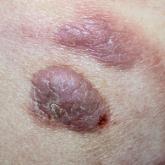Article

Antecedent Chronic Lymphocytic Leukemia May Be Associated With More Aggressive Mycosis Fungoides
- Author:
- Amrita Goyal, MD
- Daniel O'Leary, MD
- Kimberly Bohjanen, MD
Patients with mycosis fungoides (MF) are at increased risk for second hematologic malignancies, including chronic lymphocytic leukemia (CLL). This...
